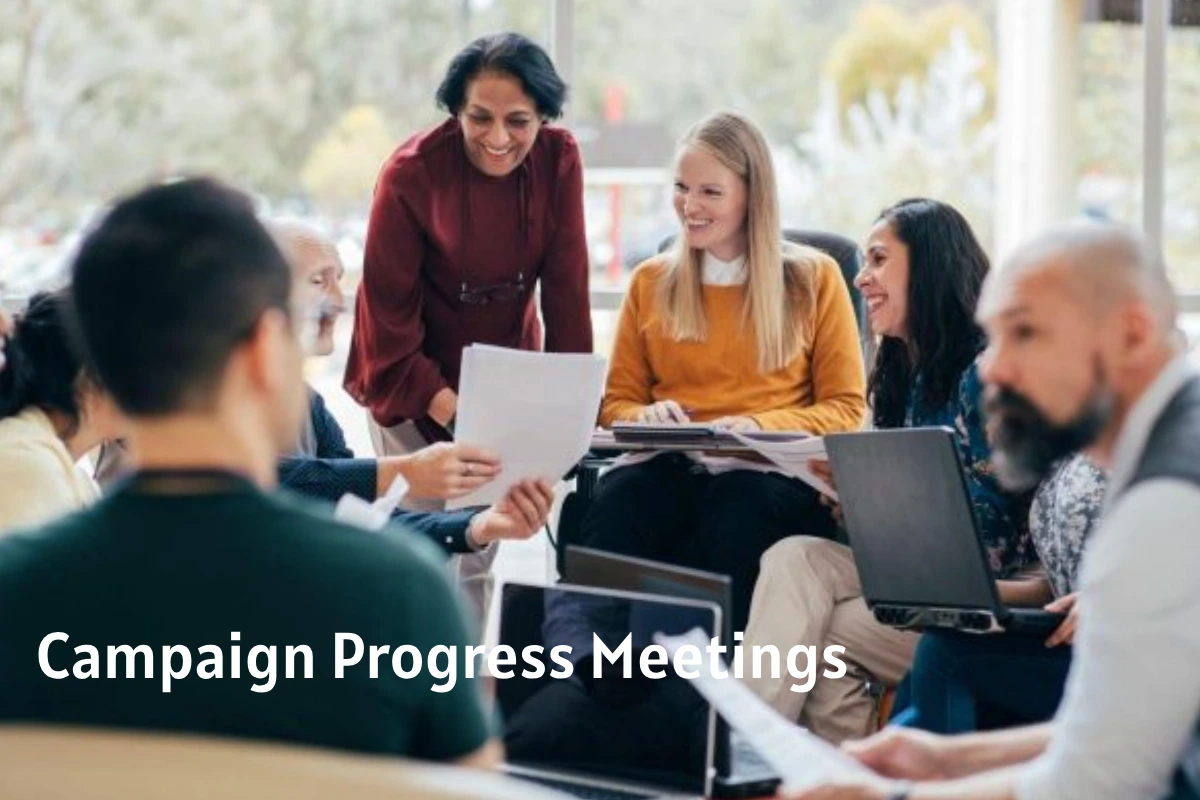About Campaign Progress Meetings
Campaign progress meetings (usually more formal) are designed to keep the pulse of the project: Schedule regular intervals (weekly, monthly, at specific milestones) to determine if the project is on track. Identify potential obstacles. Monitor the progress of the advisor.
Campaign progress meetings are crucial in project supervision, and regular meetings with the consultant and other project partners keep communication channels open.
How to Manage a Project Campaign Progress Meeting?

A plan should be distributed to participants for any project meeting you hold.
Never ask someone in the meeting for information – everyone needs time to prepare the correct data to ensure an accurate update on project progress.
But as a project manager, you must remember that a progress meeting is what it says on the tin, and you must remind attendees of this fact, if essential. A development meeting is not a time to air complaints, raise change requests, or hear the technical minutiae of an ongoing issue.
A progress meeting should be short (so book the meeting room for a limited time, probably no more than an hour), and everyone should understand your goal, simply an update on where the project is on its timeline and any issues affecting progress.
Any issues that require detailed discussion should be postponed to another meeting where you can discuss the details with only the affected people.
Under are Some Tips to Help You Achieve and Control Your Project Progress Meeting:
- Write an agenda and distribute it in advance
Even if this is one of several such meetings, a plan reminds participants of what the meeting will cover and what is likely of them. It gives everybody time to gather the progress information they need to provide at the meeting.
- Repeat the goal
The schedule should be a reminder of the purpose of the meeting but state the objectives again at the beginning of the forum and during the session if discussions are drifting off-topic.
- Review progress and future actions
Review the progress of the last meeting and the steps for the next period. It might likely do this by exception in a sizeable mature project.
- Stay focused
Stay focused on chatting progress updates, assigning actions, or revising the schedule when needed. Please don’t deal with any unrelated problem; instead, defer it to another meeting.
- Give everyone a chance to speak
No one needs to sit in a meeting listening to one person dominate the conversation, so limit the time one person can talk by moving the discussion to the next topic.
- Avoid boredom
Nothing will be accomplished if people don’t participate in the meeting, so keep sessions to an hour or less to avoid boredom.
- Assign actions
Allocate follow-up actions specifically to an individual with an expected completion date. Whoever records the meeting minutes should also create an action plan.
- Summary
At the finish of the progress meeting, condense what has been discussed, what actions have been allocated, and to whom, and set a date for the next meeting. Achieve and Report on the Progress of Fundraising Movements.
Manage and Report on the Progress of Fundraising Campaigns.
How is a fundraiser maintained? Being well organized, constantly monitoring progress, and keeping all participants informed of that progress. The real reason for the pyramid structure of a campaign committee is to simplify administration. At its best, the pyramid is built so that no one supervises more than five people. (To maintain this cap, we sometimes add campaign and division co-chairs.)
- The campaign pyramid
- Leading the meeting
- The best meeting is “Climate.”
- Corrections during the course and resolution of problems
- A deferred campaign is a defeated campaign
- Track the gifts and collect the money
- Announce the results and say thank you
- Campaign evaluation and review
- The key to a good campaign
What is a Progress Report?
A progress report is a piece of information you update about a project. Progress reports allow management and clients to stay current on a project and change or adjust tasks, schedules, and budgets.
What Types of Meetings are there?
7 Different Types of Meetings
- Meeting for decision-making. These are called when a group must perform an action
- Problem-solving meetings.
- Teamwork meetings.
- I am brainstorming meetings.
- Individual calls.
- Quarterly planning meetings.
- Registration meetings.
How does a Team Update in a Meeting?
Now let’s see how exactly you can capture the attention of a room, inform your colleagues, and excite your team with effective status meetings.
- Keep it structured. According to a recent study, 63% of meetings do not have a planned schedule.
- Take possession.
- Be specific and concise.
- Be honest.
- Prepare for the questions
Conclusion
Campaign Progress meetings are regularly scheduled events at different levels where information about a project is exchanged. Effective status meetings can build unity among teammates or colleagues based on shared goals.
Also Read: About Lead Marketing – Definition, Characterization and Challenges



